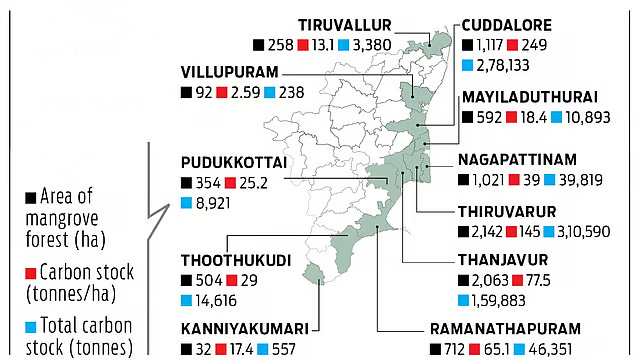Context:
A recent study by the Centre for Climate Change and Disaster Management (CCCDM) at Anna University has revealed that Tamil Nadu’s mangrove forests store an impressive 8.73 lakh tonnes of carbon stock. This makes them an invaluable asset in combating climate change.
Key Findings of the study:
According to the CCCDM study, Tamil Nadu has witnessed significant growth in its mangrove cover, expanding from 4,500 hectares in 2021 to 9,039 hectares by 2024.
This increase can be attributed to both natural regeneration and concerted afforestation efforts across the state. Notably, new plantations make up 40.1% of the total mangrove cover added in the last decade.
What are Mangroves?
Mangroves are a unique type of tree species that thrive in intertidal salty environments, particularly along the mouths of rivers and coastal deltas.
These trees are specially adapted to withstand frequent flooding and are capable of obtaining fresh water from rivers while simultaneously deriving the necessary nutrients from the surrounding saltwater.
Mangrove ecosystems are crucial for maintaining coastal stability, biodiversity, and carbon sequestration.
Features of Mangroves
1. Salt-Tolerance: Mangrove species are adapted to grow in high salinity waters and are salt-tolerant, enabling them to survive in brackish environments.
2. Salt Secretion: They have the ability to secrete salt from their leaves, helping them maintain a balance in salt intake and avoid toxicity.
3. Adapted Root Systems: Mangroves feature unique root systems, including pneumatophores (aerial roots) that grow upwards above the water, allowing the trees to breathe in oxygen from the air when submerged during high tides.
4. Temperature Resistance: These trees have developed resistance to high temperatures, further aiding their survival in challenging coastal environments.
5. Viviparous Reproduction: Mangroves reproduce through a viviparous method, where the seeds germinate while still attached to the parent tree, and the young plants drop into the water, where they continue to grow.
Significance of Mangroves
1. Biodiversity Hotspot: They support a rich diversity of life, including fish, reptiles (like sea turtles, alligators, and crocodiles), and various invertebrates (e.g., crabs, oysters, snails, and insects).
2. Coastal Protection: The dense root systems of mangrove trees trap sediments and help stabilize the coastline, preventing erosion caused by waves and storms. They act as natural barriers, offering protection against cyclones, storm surges, and rising sea levels.
3. Nutrient Cycling: Mangroves play an essential role in nutrient cycling by filtering water and helping maintain coastal ecosystems, making them essential for sustaining marine biodiversity.
4. Breeding Grounds: Mangrove forests serve as crucial breeding and nursery areas for marine species, offering shelter and food for juvenile fish and other aquatic animals.
5. Carbon Sequestration: Mangrove forests act as carbon sinks, absorbing significant amounts of carbon dioxide from the atmosphere and storing it in their biomass and soil, thus helping mitigate the effects of climate change.








